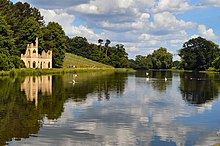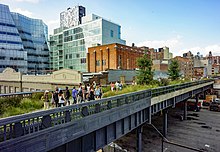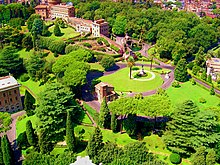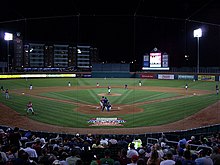Organic lawn management

Organic lawn managementororganic turf managementororganic land careororganic landscapingis the practice of establishing and caring for an athleticturf fieldorgardenlawnand landscape usingorganic horticulture,without the use of manufactured inputs such as syntheticpesticidesorartificial fertilizers.It is a component of organic land care and organicsustainable landscapingwhich adapt the principles and methods ofsustainable gardeningandorganic farmingto the care of lawns and gardens.[1]
Techniques[edit]


A primary element of organic lawn management is the use ofcompost[2]andcompost teato reduce the need for fertilization and to encourage healthy soil that enables turf to resist pests.[3]A second element is mowing tall (3 "- 4" ) to suppress weeds and encourage deep grass roots,[4]and leaving grass clippings and leaves on the lawn as fertilizer.[5]
Additional techniques include fertilizing in the fall, not the spring.[6]Organic lawns often benefit from over seeding, slice seeding and aeration more frequently due to the importance of a strong root system. Well-maintained organic lawns are often drought-tolerant. If a lawn does need watering it should be done infrequently but deeply.[7]
Other organic techniques for caring for a lawn includeirrigationonly when the lawn shows signs of drought stress and then watering deeply - minimizing needless water consumption. Using low volumesprinklersprovides more penetration withoutrunoff.Lawnmowerswith amulchingfunction can useful in reducing fertilizer use by allowing grass clippings and leaves that are cut so minutely that they can settle into the grass inconspicuously todecomposeinto thesoil.
Clover lawns[edit]
Grass seed mixes used to contain white clover, which provides natural fertilizer, but this practice fell out of favor with the rise of synthetic fertilizer and businesses profiting from the sale of this fertilizer. In recent years, homeowners have returned to the use of clover as a natural fertilization source for lawns. In 2022, theNew York Timesreported on the growing popularity of clover lawns. TheNew York Timesreported "#cloverlawn has over 65 million views onTikTok."[8]
Organic pesticides[edit]
Organic land managers may use registered pesticides approved under theNational Organic Programin their lawn care programs. These pesticides are generally derived from natural materials and are minimally-processed. Alternatives include the use ofbeneficial insectsand natural predators such asnematodesto prevent infestation of lawns with pests such ascrane flylarvae andants.Pesticides are allowed under the NOFA Standards for organic land care[9]but not always used in organic lawn care because proper cultural practices can keep pest populations below action thresholds, such as preventing fungal infections using physical maintenance techniques such as effective mowing and raking.
Organic fertilizers[edit]
Synthetic (inorganic based)fertilizersare made in chemical processes, some of which use fossil fuels and contribute to global warming. They also greatly increase the amount of nitrogen entering the global nitrogen cycle which has a serious negative impact on the organization and functioning of the world's ecosystems, including accelerating the loss of biological diversity and decline of coastal marine ecosystems and fisheries.[10]Nitrogen fertilizer releases N2O, a greenhouse gas, into the atmosphere after application.[11]Organic fertilizer nitrogen content is typically lower than synthetic fertilizer.[12]
Biodiversity[edit]
Organic lawns contribute tobiodiversity,by definition, when they contain more than one or two grass species. Examples of additional lawn and grasslike species that can be encouraged in organic lawns include dozens of grass species (eight for ryegrass alone,sedges,mosses, clover, vetches, trefoils, yarrow,ground cover alternatives,and other mowable plants[13]).[14]Biodiversity increases the functioning and stress tolerance of ecosystems.[15]Lack of biodiversity is a significant environmental issue brought up by the use of lawns with grassroots groups emerging to promote this method of lawn care.[16]Certain low-growing grass species can also eliminate the need for mowing, thus also being environmentally friendly.Cloveris often mixed with grasses for its ability to fix nitrogen into the soil and fertilize the lawn.
No Mow May[edit]
No Mow May is a campaign to encourage homeowners to not mow their lawns during the month of May to supportpollinators,native plantsand wildlife diversity.[17][18]The campaign was started in 2019 byPlantlife,a nature conservation charity based in the United Kingdom. In 2020, the city ofAppleton, Wisconsinstopped mowing for the month of May. In 2022, cities around the United States participated in No Mow May. The campaign is supported by theXerces Societythrough its Bee City USA program, and has described the movement as a "gateway" to creating better habitat for bees when adapted to local conditions and including native wildflowers.[19][20]
Locations with organic lawns[edit]
Many small properties with lawns around the world are maintained using organic techniques. In the late 20th century, a movement to manage lawns organically began to grow.[21]Some large properties and municipalities require organic lawn management and organic landscaping. They include the following locations:
Ryton Organic Gardens, Ryton-on-Dunsmore, Warwickshire, England[edit]

In 1985, the nonprofitGarden Organic,formerly known as the Henry Doubleday Research Association, relocated to its present site where it operates organic, landscaped grounds open to the public. The property is owned byCoventry University.[22]
Highgrove House estate, Gloucestershire, England[edit]
In 1996,King Charles III,then the Prince of Wales, had transitioned theHighgrove Houseestate's farm and gardens to organic management.[23]
Painshill, Cobham, Surrey, England[edit]
In 1998,Painshillwas awarded theEuropa Nostra Medalfor its restoration of the 18th century organic gardens originally designed byCharles Hamiltonbetween 1738 and 1773 using what today are called organic methods.[24][25]
Common Ground Education Center, Unity, Maine, United States[edit]
In 1998, theMaine Organic Farmers and Gardeners Associationacquired the 300 acre property inUnity, Maine,and converted the land to organic demonstration fields, gardens, orchards, shade trees and low-impact forestry woodlots. It is the site of the annualCommon Ground Country Fair,a fair showcasing organic food and farming.[26]
Vineyard Golf Club, Martha's Vineyard, Massachusetts, United States[edit]
In 2002, theVineyard Golf Clubopened on Martha's Vineyard with the requirement that it use organic turf management. The first course superintendent, Jeff Carlson, was the recipient of the 2003 GCSAA/Golf Digest Environmental Leaders in Golf Award and is the 2008 winner of the President's Award forEnvironmental Stewardship.[27]
Harvard University, Massachusetts, United States[edit]

In 2009, theNew York Timesreported onHarvard University's decision to use organic management on all their grounds, which was championed by PresidentDrew Gilpin Faustand implemented by landscape director Wayne Carbone. The New York Times noted: "Thanks to these efforts, the university has reduced the use of irrigation by 30 percent, according to Mr. Carbone, thus saving two million gallons of water a year. And the 40-year-old orchards at Elmwood, which have been treated with compost tea, are recovering from leaf spot and apple scab, two ailments that had afflicted them."[28]
High Line, Manhattan, New York, United States[edit]

In 2009, the first section of the organically-managed 1.45 mile linear park theHigh Lineopened on the formerNew York Central Railroad,an elevated train line spur, on thewest sideofManhattanin New York City. The High Line's design is a collaboration betweenJames Corner Field Operations,Diller Scofidio + Renfro,andPiet Oudolf.[29]
Takoma Park, Maryland, United States[edit]
Residents Catherine Cummings and Julie Taddeo began a campaign in 2011 to restrict lawncare pesticide use inTakoma Park,Maryland.City council members Seth Grimes and Tim Male quickly got behind the effort and drafted Takoma Park's Safe Grow Act of 2013, leading to the city council's enactment of the law,[30]which went into effect March 1, 2014.[31]
Ogunquit, Maine, United States[edit]
In 2014, Bill and Judy Baker and other residents convinced theOgunquitTown Council to pass a strict pesticide ban requiring organic land care on both public and private property.[32][33]
Montgomery County, Maryland, United States[edit]

In 2015, Julie Taddeo and Catherine Cummings and Safe Grow Montgomery colleagues campaigned to getMontgomery County,Marylandto adopt a pesticide ban that required organic lawn management throughout the county on both public and private property. Montgomery County Council President George Leventhal (D-at-large) wrote and introduced Bill 52-14,[34]based on Takoma Park's 2013 legislation. The county council enacted Bill 52-14 that October.[35]The ban was challenged in court by local lawn care companies and pesticide industry lobbying group Responsible Industry for a Sound Environment (RISE). In 2017, the ban was overturned by a Circuit Court, and the ruling was appealed. In 2019, a Maryland appeals court upheld the ban.[36]

Irvine, California, United States[edit]
In 2016,Non Toxic Irvinea group led by citizens Laurie Thompson, Ayn Craciun, Kathleen Hallal, Kim Konte and Bob Johnson with help from City Councilor Christina Shea convinced the City Council to adopt an organic integrated pest management program requiring organic land care on all city property.[37][38]
Carlsbad, California, United States[edit]
In 2017, Non ToxicCarlsbadcampaigned to get the city to adopt an ordinance requiring organic land care on all city property.[39]
Portland, Maine, United States[edit]
In 2018, Portland Protectors led byAvery Yale Kamilaand Maggie Knowles convinced thePortlandCity Councilto adopt an organic ordinance requiring organic land care on all public and private property.[40]
Dover, New Hampshire, United States[edit]
In 2018, the Dover City Council unanimously approved a resolution calling for a "Commitment to Organic Land Management Practices" brought to the Council by resident groupNon Toxic Dover, NHand sponsored by Councilor Dennis Shanahan. The City began an all-organic turf program for City property in 2020.[41][42]
Gardens of Vatican City, Rome, Italy[edit]
In 2019, Rafael Tornini, head of the Garden and Environment Service of theVatican,announced the 37 acreGardens of Vatican Cityhad been transitioning to organic management since 2017.[43]

Delta Dental Stadium, Manchester, New Hampshire, United States[edit]
In 2019, theNew Hampshire Fisher Catsbegan the transition to makeDelta Dental Stadiumthe first professional baseball field that is organically managed.Stonyfield,as part of its #playfree campaign to convert recreational spaces to organic management, supported the field's transition.[44]
New York City public lands, United States[edit]
In 2021, the New York City Council banned the use of synthetic pesticides by city agencies. The effort was started by teacher Paula Rogovin's kindergarten class at P.S. 290.[45]
Maui, Hawaii, United States[edit]
In 2021, the island ofMauibanned synthetic pesticides and fertilizers from all county lands. Community organizers including Autumn Ness, director of Beyond Pesticides' Hawai'i Organic Land Management Program worked to enact the law.[46]
Baltimore, Maryland, United States[edit]
In 2022, a synthetic pesticide ban on public and private property passed by theBaltimore City Councilin 2020 went into effect. It includes a fine of up to $250 for violators.[47]
Books[edit]
- "NOFA Standards for Organic Land Care 6th Edition Practices for the Design and Maintenance of Ecological Landscapes,[48]"Michael Almstead, Dr. Jamie Banks, et al., contributors. Northeast Organic Farming Association of Connecticut, Inc. 2017.
- "The Organic Lawn Care Manual: A Natural, Low-Maintenance System for a Beautiful, Safe Lawn," by Paul Tukey.Storey Publishing,LLC. 2007.,
See also[edit]
References[edit]
- ^Pandolfi, Keith (May 14, 2007)."Tips for a Lush, Organic Lawn".This Old House.RetrievedMarch 6,2020.
- ^U.S. EPA Composting
- ^Organic Landscaping at Harvard University
- ^University of Minnesota Sustainable Urban Landscape Mowing Practices
- ^MassDEP Don't Trash Grass
- ^Cornell University, Lawn Care Without Pesticides
- ^"Organic Lawn Care"(PDF).Molloy College.RetrievedMarch 2,2020.
- ^Kambhampaty, Anna P. (September 10, 2022)."Clover Lawns Are Blooming in Front Yards, and on TikTok".The New York Times.ISSN0362-4331.RetrievedSeptember 17,2022.
- ^NOFA Standards for Organic Land Care, 6th edition, November 2017https://nofa.organiclandcare.net/the-standards/
- ^U.S. EPA The Global Nitrogen Cycle
- ^Carbon sequestration and greenhouse gas emissions in urban turf, Amy Townsend-Small1 and Claudia I. Czimczik1, GEOPHYSICAL RESEARCH LETTERS, VOL. 37, L02707
- ^Arizona Cooperative Extension Organic Fertilizers
- ^Royal Botanic Garden Edinburgh
- ^Canada Mortgage and Housing Corporation Low-Maintenance Lawns
- ^Sustaining multiple ecosystem functions in grassland communities requires higher biodiversity
- ^Northeast Organic Farming Association Organic Land Care Program
- ^"Need an excuse not to mow your lawn? Join 'no mow May' and help pollinators".NPR.org.RetrievedJune 16,2022.
- ^Roach, Margaret (June 15, 2022)."Yes, You Can Do Better Than the Great American Lawn".The New York Times.ISSN0362-4331.RetrievedJune 16,2022.
- ^"Why More Americans Are Rethinking Their Lawns".Modern Farmer.May 30, 2022.RetrievedJune 16,2022.
- ^No Mow May: A Gateway To Better Landscape Management For Bees, Xerces Society, May 4, 2023,https:// xerces.org/blog/no-mow-may-gateway-to-better-landscape-management-for-bees
- ^Land, Leslie (April 12, 2007)."Are Bugs the Pests, or Humans? Organic Lawns Take Hold".The New York Times.ISSN0362-4331.RetrievedSeptember 17,2021.
- ^"Ryton's new garden opens to teach green and healthy ways".Rugby Observer.RetrievedFebruary 19,2023.
- ^Aslet, Clive (November 12, 2018)."Inside the private world of Prince Charles: What's life really like for our future king?".The Telegraph.ISSN0307-1235.RetrievedMarch 6,2020.
- ^"The restoration of Painshill's English landscape garden".Financial Times.September 26, 2014.RetrievedFebruary 19,2023.
- ^"Painshill Landscape Garden | Surrey - Great British Gardens".greatbritishgardens.co.uk.RetrievedFebruary 19,2023.
- ^"Common Ground Education Center".Maine Organic Farmers and Gardeners.RetrievedSeptember 24,2023.
- ^Pennington, Bill (August 17, 2010)."Exclusive Golf Course Is Organic, So Weeds Get In".The New York Times.ISSN0362-4331.RetrievedFebruary 23,2023.
- ^Raver, Anne (September 23, 2009)."The Grass Is Greener at Harvard".The New York Times.ISSN0362-4331.RetrievedMarch 3,2020.
- ^Roach, Margaret (June 26, 2024)."The High Line Opened 15 Years Ago. What Lessons Has It Taught Us?".The New York Times.ISSN0362-4331.RetrievedJune 26,2024.
- ^"Safe Grow Act of 2013"(PDF).August 12, 2013.RetrievedMay 4,2021.
- ^"Safe Grow".RetrievedMay 4,2021.
- ^Wright, Virginia M. (March 11, 2015)."Ogunquit Leads the Way".Down East.RetrievedMarch 3,2020.
- ^Idlebrook, Craig (March 16, 2015)."Ogunquit lawns go organic".Working Waterfront.RetrievedMarch 3,2020.
- ^Turque, Bill (March 8, 2015)."Proposed ban on cosmetic pesticides causes turf war in Montgomery County".Washington Post.RetrievedMay 4,2021.
- ^Metcalf, Andrew (October 6, 2015)."Council Passes General Ban on Pesticides".Bethesda Magazine.RetrievedMay 4,2021.
- ^Barrios, Jennifer (May 3, 2019)."Appeals court finds Montgomery County pesticide ban doesn't clash with state law".Washington Post.RetrievedMarch 3,2020.
- ^D, Kelsen (July 6, 2016)."HOW IRVINE BECAME SOCAL'S FIRST NON-TOXIC CITY".RetrievedMarch 4,2020.
- ^Organic Pesticides Program, City of Irvine California https:// cityofirvine.org/news-media/news-article/organic-pesticides-programRetrieved February 6, 2024
- ^Diehl, Phil (December 27, 2017)."Carlsbad adopts organic pesticide policy".San Diego Union-Tribune.RetrievedMarch 4,2020.
- ^Billings, Randy (January 4, 2018)."Portland's tough new ban on synthetic pesticides allows few exceptions".Portland Press Herald.RetrievedMarch 6,2020.
- ^Dover council votes to go organic on city land, Kimberley Haas, Union Leader, February 28, 2018,https://web.archive.org/web/20180318202103/https:// unionleader /local-government/dover-council-votes-to-go-organic-on-city-land-02282018/
- ^It’s Official – Dover’s Gone Organic!, Non Toxic Dover, NH, June 25, 2020,https://nontoxicdovernh.wordpress /2020/06/25/its-official-dovers-gone-organic/
- ^Caldwell, Zelda (August 2, 2019)."The Vatican Gardens are going" green "".Aleteia — Catholic Spirituality, Lifestyle, World News, and Culture.RetrievedMarch 6,2020.
- ^"The New Hampshire Fisher Cats Go Organic".New Hampshire Public Radio.April 22, 2019.RetrievedFebruary 18,2023.
- ^Barnard, Anne (April 24, 2021)."N.Y.C. Bans Pesticides in Parks With Push From Unlikely Force: Children".The New York Times.ISSN0362-4331.RetrievedSeptember 16,2021.
- ^"Pesticide ban victories".EHN.November 16, 2021.RetrievedJune 3,2022.
- ^"Baltimore city bans pesticide use in public parks, private lawns".WYPR.June 29, 2022.RetrievedMarch 29,2023.
- ^Michael Almstead, Dr. Jamie Banks, et. al, contributors (2017).The NOFA Standards for Organic Land Care, 6th Edition.Northeast Organic Farming Association of Connecticut, Inc.ISBN978-0-692-58435-4.
{{cite book}}:|first=has generic name (help)CS1 maint: multiple names: authors list (link)
